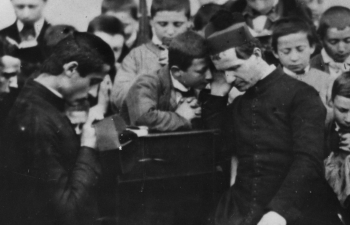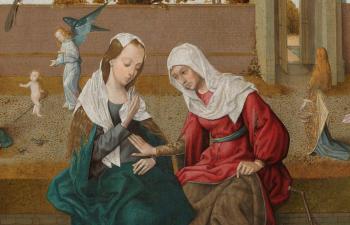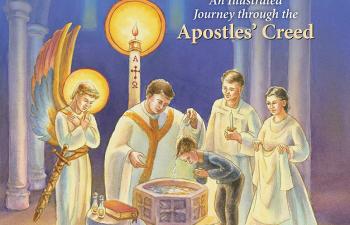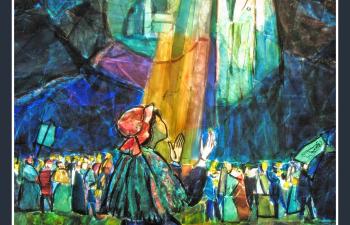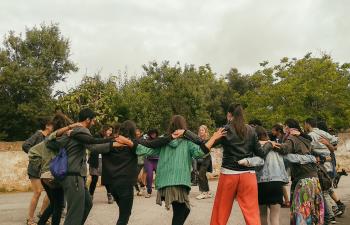
It is a historic time to be a part of youth and young adult ministry. The upcoming Synod on “Young People, the Faith, and Vocational Discernment” is inspiring conversations across the world. Here in the United States, the Hispanic/Latino community has engaged in the Fifth Encuentro with an emphasis on young, second and third generation Hispanics/Latinos. Another important movement is “The National Dialogue of Catholic Pastoral Ministry for Youth and Young Adults”, which is a collaborative effort between the USCCB, The National Federation for Catholic Youth Ministry, the USCCB National Advisory Team on Young Adult Ministry, and the National Catholic Network de Pastoral Juvenil Hispana (LaRED).
It is well documented that many young people no longer affiliate themselves with being Catholic, or any religion at all. Before we can propose what can be done about this, some attention must be given to who these young people are. To do so challenges not only our pre-conceived notions but also the vocabulary we use when we speak of young people or youth or young adults.
Defining Youth
There is a trend among sociologists to delineate three stages of growth between childhood and adulthood. “Generally speaking, early adolescence corresponded to junior high. Middle adolescence was understood to be the new high school phenomena, while late adolescence was pushed to the college years and beyond.”[1] Those in early adolescence are commonly referred to as “tweens.” Late adolescence has been called “young adulthood” but more recently has also become known as emerging adulthood.[2]
In the United States, ministry to the young has traditionally been put into two age groups: “youth ministry,” which means junior high and high school students (12-18 years of age), and “young adult ministry,” which the document Sons and Daughters of the Light in 1997 defined as people “in their late teens, twenties, and thirties; single, married, divorced, or widowed; and with or without children.”[3] The demarcation line of 18-years-of-age reflected the average age when one graduated high school. However, in the Hispanic/Latino culture, jóvenes are described as single people roughly between the ages of fifteen and thirty.[4] To add to the linguistic confusion, there is also a popular genre of literature and movies that is known as “young adult” whose audience is primarily adolescents.
Vatican documents, such as The General Directory for Catechesis, describe “young people” as pre-adolescents, adolescents, and young adults,[5] but the “Preparatory Document” for the Synod “refers to persons who are roughly 16 to 29 years old” but added that “the term needs to be adapted to local circumstances.”[6]
These problems in identifying the parameters of youth also apply to defining what it means to be an adult. It has been argued that characteristics that used to belong to teens or mid-adolescents have now extended into late adolescence or young adulthood and that the period of youth has expanded. Assuming marriage age is one of the accurate indicators for adulthood, in 2010 the average age for marriage was 28.2 for men and 26.1 for women, the highest in recorded history.[7] Only slightly more than half of twenty-five-year-olds in 2015 were financially independent, another common indicator of adulthood.[8] One book on the subject had a chapter titled, “Is Twenty-five the New Fifteen?”[9]
Implications for ministry
From one book to another, or even one Church document to another, a reader can find different usages of the word “youth.” For example, people who are accustomed to the “youth and young adult” nomenclature and think of “youth” as high school and junior high students are often surprised to find that events such as “World Youth Day” or resources such as the YOUCAT are targeted toward people in their twenties, not teens. It is reminiscent of the famous quote from the movie Cool Hand Luke: “What we have here is a failure to communicate.” Steven Bonner wrote, “The lack of consensus in the literature with regard to the age that adolescence begins or ends, whether two or three stages exist, or how age corresponds to these stages is evidence enough that, at best, the landscape is constantly changing and, at worst, something is amiss.”[10]
The traditional US usage of “youth and young adults” is being challenged by the emerging Latino population and also the language of the 2018 Synod. One might wonder if the United States, specifically the USCCB, might try to create more uniformity in the language and go with the wider definition of youth. That may solve one problem but could create another: since that definition usually begins with people in their later teenage years, what of the younger teens that have been the focus of so much “youth ministry” in the United States?
A new way of looking at young people
It remains to be seen how the usage of these terms may evolve over the next couple years. Regardless of how the words are used, it is important we don’t fall into a common problem described by Tony Vasinda of ProjectYM: “In the US, we have typically defined ministry to young people based on their age but not where they are on their spiritual journey.” While this “age-based” approach can have benefits in fields such as education or psychology, it fails when it defines our pastoral practice towards young people. One could argue that the continual debate about the most appropriate age for the Sacrament of Confirmation is a symptom of this issue.
There are seventeen-year-olds who are committed disciples of Jesus Christ; there are twenty-five-year-olds who are only just starting to think about their relationship with the Catholic Church. How might the Church give language to those pastorally accompanying such young people to guide them towards spiritual maturity?
I would like to propose, drawing from a major theme of the upcoming Synod, that we do so in light of vocation. The first call is to holiness: “Be perfect, as your heavenly Father is perfect.”[11] The Catechism contains a beautiful quote from St. Gregory of Nyssa: “Christian perfection has but one limit, that of having none.”[12] All are called to walk in the way of love modeled by Jesus Christ and empowered by the Holy Spirit. All are invited to give their fiat as Mary did and experience the “abundant life” that only Christ can give. The upcoming Synod’s focus on faith addresses this important call.
Only after one experiences living with Jesus in this way are they open to discerning how to live out that vocation of love. The “Preparatory Document” for the Synod states, “For the believer, the question becomes even more intense and profound, namely, how does a person live the good news of the Gospel and respond to the call which the Lord addresses to all those he encounters, whether through marriage, the ordained ministry or the consecrated life?”[13]
Viewing young people in consideration of where they are in response to these vocations (first to holiness, then to service) could provide a more effective language of understanding the best way to serve them. Currently, the USCCB (through the 1997 documents Renewing the Vision and Sons and Daughters of the Light) has proposed three goals for youth ministry and four for young adults. While not disparate from each other, they are also not the same. Could there be a united vision for both youth and young adults (or just “youth”) that articulates a foundational goal of helping young people discern their vocations, first to God and from that to others?
This kind of goal would not only help the Church understand where ministry to youth starts (when they are able to contemplate the call to discipleship) but also where it ends. When does a “young adult” become an “adult”? Though there are many things to consider when answering that question, I propose that we deal with a twenty-four-year-old newly married couple differently than a twenty-eight-year old who is still discerning his or her vocation. I’m not suggesting we don’t do ministry to the newly married couple—only that it is a different kind of ministry. They are no longer discerning a vocation; they are trying to live it out (assuming the couple are disciples of Jesus and are truly attempting to live out their marriage as a sacrament, not just a contract). That implies a different kind of pastoral approach.
Conclusion
The “Preparatory Document” for the Synod states that “it is good to remember that the term ‘youth’, in addition to referring to persons, is a stage of life that each generation understands in an unequal, original manner.”[14] Understanding the age of youth is important so that our methodologies are appropriate to where one is in their physical, cognitive, and emotional development. However, from a pastoral perspective, purely defining young people in this way is confusing for those who minister to this group and can diminish our effectiveness toward them. If our definition of youth could move from an “age group” towards an understanding of where they are in their spiritual journey, I believe we would have greater clarity not only in articulating what a young person is but also the best practices of sharing the faith with them.
Dr. Bob Rice is the Director of the Master of Arts in Catechetics and Evangelization at Franciscan University of Steubenville and a nationally recognized expert in the field of Catholic youth ministry.
Notes
[1] Steven Bonner, “Understanding the Changing Adolescent” in Adoptive Youth Ministry, ed. Chap Clark (Grand Rapids: Baker Academic, 2016), 25.
[2] “The theory of emerging adulthood has been offered as a way of conceptualizing the development of today’s young people, in American society and in other industrialized societies.” Jeffrey Jensen Arnett, “Emerging Adulthood: Understanding the New Way of Coming of Age” in Emerging Adults in America: Coming of Age in the 21st Century, eds. Jeffrey Jensen Arnett and Jennifer Lynn Tanner (Washington DC: American Psychological Association, 2006), 4.
[3] USCCB, Sons and Daughters of the Light, 7.
[4] Conclusions, 19.
[5] Cf. General Directory for Catechesis, no. 181.
[6] Synod of Bishops XV Ordinary General Assembly, “Young People, the Faith, and Vocational Discernment Preparatory Document”, http://www.vatican.va/roman_curia/synod/documents/rc_synod_doc_20170113_....
[7] ‘Median Age at First Marriage, 1890-2010’, Information Please Database. <http://www.infoplease.com/ipa/A0005061.html> [accessed 30 September 2015]. Other indicators of adulthood can be holding a job or achieving financial independence.
[8] “Determining when an individual becomes an adult is difficult. In the United States, the most widely recognized marker of entry into adulthood is holding a more or less permanent, full-time job, which usually happens when an individual finishes school—high school for some, college for others, graduate or professional school for still others. However, other criteria are far from clear. Economic independence is one maker of adult status, but achieving it is often a long process.” John Santrock, Adolescence: Fifteenth Edition (New York: McGraw Hill, 2014), 20.
[9] “Adolescence was supposed to be the period during which the traits of adulthood gradually emerged. Now the emergence of these same traits was being studied, but a decade later in the life span. And it the twenties are when adulthood is supposed to be just emerging, what does that mean our teens are supposed to be doing? Have we turned the teen years into a supersize extension of childhood? And if so, what does this do to these teens’ efforts to grow up?” Joseph Allen and Claudia Worrell Allen, Escaping the Endless Adolescence (New York: Ballantine, 2009), 14.
[10] Bonner, “Understanding the Changing Adolescent”, 26.
[11] Matthew 5:48.
[12] Catechism of the Catholic Church, par. 2028.
[13] Synod of Bishops, “Preparatory Document”. Though primarily focused on the sacraments of service, the document also examines vocational discernment in broader sense: “Where can a person’s talents be put to good use: a professional life, volunteer work, service to the needy or involvement in civil and political life?”
[14] Synod of Bishops, “Preparatory Document.”
Art Credit: Public Domain image from Pixabay.com.
This article is from The Catechetical Review (Online Edition ISSN 2379-6324) and may be copied for catechetical purposes only. It may not be reprinted in another published work without the permission of The Catechetical Review by contacting [email protected]




